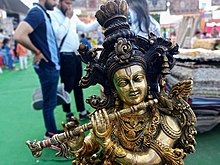Flute - Simple English Wikipedia, the free encyclopedia

The flute is a musical instrument.[1] A person who plays the flute is called a flautist.
There are many kinds of flutes.[2] The most common concert flute is on C tuning. In addition, there are other flutes like piccolos, alto flutes, and bass flutes.
Flutes have changed over time. Pan flutes were made for many centuries. Later, the "Renaissance flute" came into use. In Baroque music flute means recorder, so flutes were called traverso in order not to confuse them. A Bavarian flute maker named Boehm reformed flutes largely to enlarge the volume and improve the way of using the chromatic scale. Later improvements created the modern flute.
There is a large repertoire of music for the flute. Baroque composers used them in their orchestras, usually in pairs, and composed concertos, chamber music and solo music for them. This has continued to the present day. Orchestras have at least 2 flutes each, sometimes three or four. Sometimes there is 1 piccolo which plays an octave higher, or an alto flute which plays a fifth lower than the flute.
The flute sounds very bright and cheerful playing high notes. Please listen, for example, to the Badinerie from Bach's Orchestral Suite no 2. It can also sound very thoughtful or sad when playing in its lowest register. A good example is the opening of Debussy's Prélude à l'après midi d'un faune also flutes Andre a brass instrument and can make a really low pitch.
Playing
[change | change source]
The flute is a woodwind instrument, but modern flutes are made of metal. It was made of wood a long time ago. It doesn't need lip vibration like brass instruments. Flute players hold it horizontally and make a sound by blowing their breath over the edge of the hole of flute's head. This makes the air vibrate. Flutes need the second most amount of air for an instrument, next to the tuba. Flautists can change the pitch by pushing buttons or changing the direction of the breath. These buttons are called keys. The breath also can change the tone or the volume. Flute has many variations of the sound. The sound of flute is high, so composers often express it as a bird. A flute matches with many instruments such as violin and piano, and is often part of an ensemble.
Material
[change | change source]There are many kinds of flute, so the material also varies.[2] Most flutes are made out of silver. Gold, platinum, wood, and aluminum are also used. The price of flute depends on the material, but there are many different playing situations, so not only expensive flutes are useful.
Different Flutes
[change | change source]Flutes of India and China
[change | change source]The oldest kind of side-blown flute was made in India. In India, a flute called bansuri is used. It has no keys and is often made of bamboo or cane.

In China, a simple flute is used, which has no keys. The Chinese flute sometimes has a thin piece of paper over one hole, which adds a bright raspiness to the sound.
Other flutes
[change | change source]There are other kinds of flute, that are played by blowing into the end, like a recorder. Some of these are tin whistle, flageolet, tabor pipe, and ocarina, and slide whistle.
In Japan there is a kind of flute called a shakuhachi, which is made from the bottom of a bamboo plant. It is blown at the end, but is not like the recorder because it does not have an opening that guides the air across a hole that makes the sound.
In South America, there is a flute called a quena that makes its sound the same way as the shakuhachi.
The Pan pipes are a form of flute with no holes. It has more than one pipe connected together, with the bottom closed. The player blows across the top of one of the pipes to make a note. The pipes are in different sizes, so that each one makes a different note. They are named after Pan, who played this instrument in Greek myth.
Gallery
[change | change source]There are flutes in many cultures. The flute has been described as "a musical weed which springs up everywhere".[3]
- A flute in India
- A flute in Burma
- A flute in Japan
- A piccolo in the US
Famous Flutists
[change | change source]The band Jethro Tull was founded by a flute player (Ian Anderson). It can be heard in many songs. One of them is the hit "Locomotive Breath".
Related pages
[change | change source]References
[change | change source]- ↑ Toff, Nancy (1996). The Flute Book: A Complete Guide for Students and Performers. Oxford University Press. p. 3. ISBN 978-0-19-510502-5.
- ↑ 2.0 2.1 Sugita.co.jp, フルートの選び方 (Choice of flute) Archived 2012-05-18 at the Wayback Machine; retrieved 2012-6-19.
- ↑ The Musical Times. Novello. 1901. p. 8.
Other websites
[change | change source]![]() Media related to Flutes at Wikimedia Commons
Media related to Flutes at Wikimedia Commons


 French
French Deutsch
Deutsch


